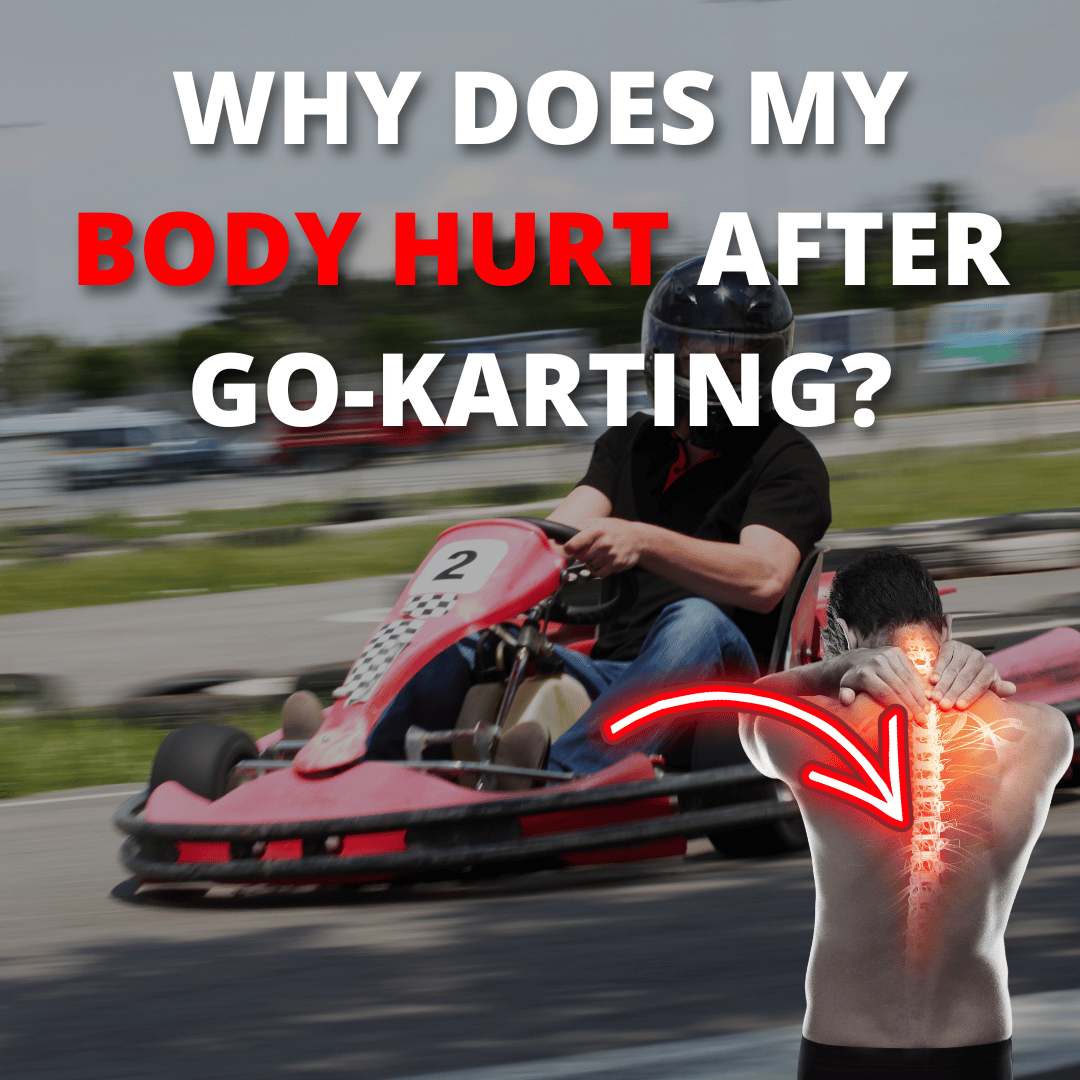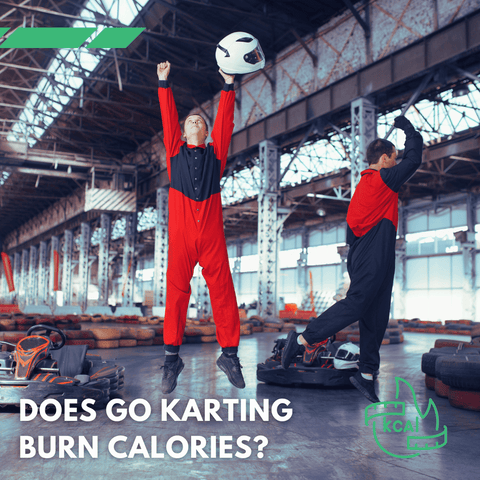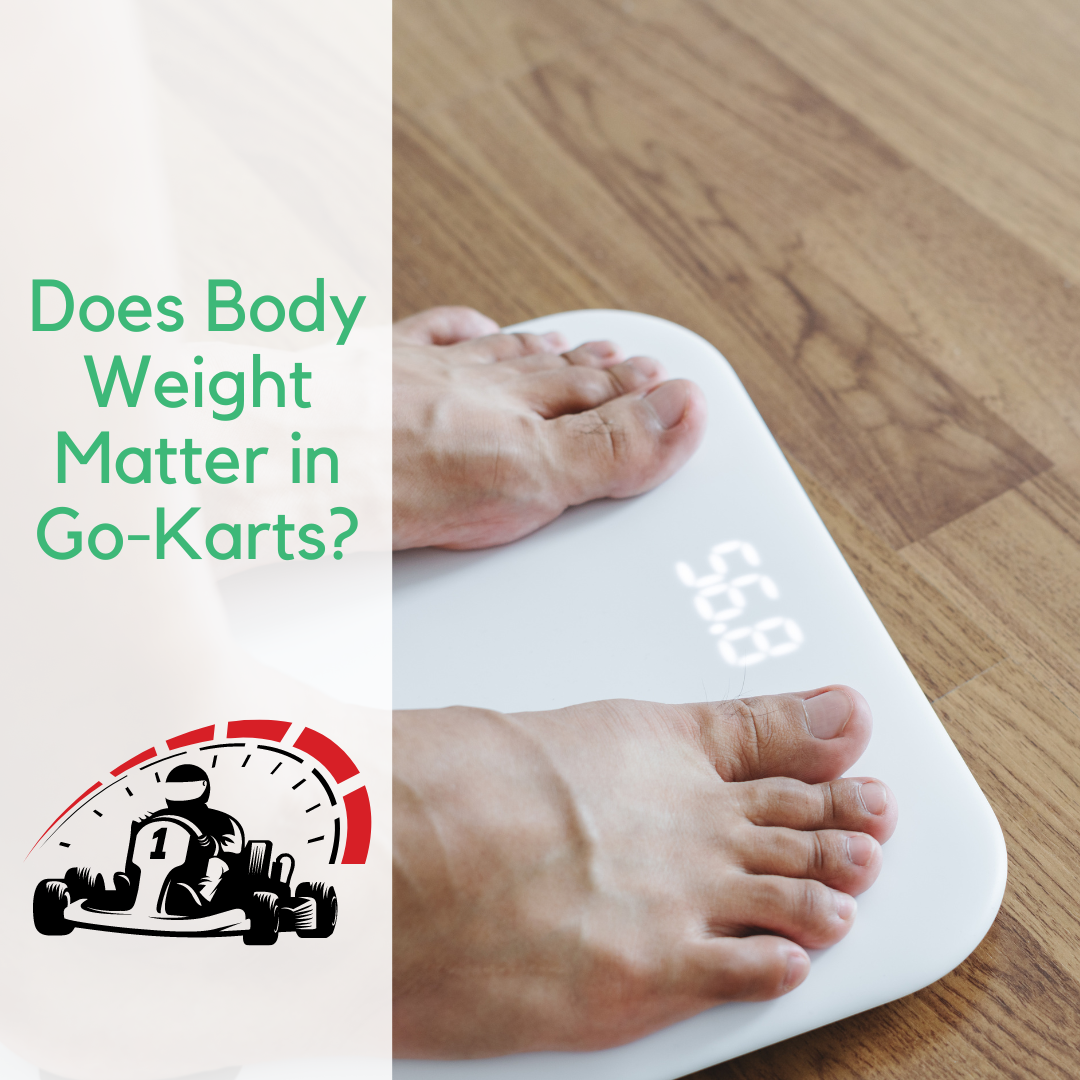Published: 13.7.23
Updated: 9.9.24
Have you ever wondered why you feel so sore after a thrilling go-kart race?
Also, just a side bar, Why is go-karting so tiring?
If so, you're not alone. 
This post will delve into the reasons why go-karting can leave your body feeling as if you've just completed a strenuous workout.
The Short Answer to "Why Does My Body Hurt After Go-Karting?"
Experiencing bodily pain post go-karting is a common phenomenon and a natural bodily response. The exertion placed on your muscles during this activity causes microscopic tears in muscle fibers. This may result in temporary discomfort or soreness. As these minor injuries repair, they strengthen your muscles, making them more resilient for future exertion. This process is the basis of muscle development and strength building, contributing to your overall physical fitness.
An Introduction to Go-Karting
Go-karting has been a beloved pastime for decades, offering a taste of the adrenaline-fuelled world of racing to enthusiasts of all ages.
If you're looking to delve deeper into this exhilarating sport, here's a guide on how to get into go-kart racing.
It's an activity that calls for skill, precision, and quick reflexes. However, behind all the fun and excitement, there's a physical toll that this activity takes on your body.
The Physical Demands of Go-Karting
The need for agility and muscle control during go-karting often means you'll find yourself flexing muscles that are seldom used in everyday life.
This article explains the science of go-karting and its physical demands in detail.
You're required to make quick, precise movements, using your arms and shoulders extensively to manoeuvre the kart around the track.
Related: Is Go Karting Bad For Your Back?

Core Muscle Involvement
Your core plays a crucial role in go-karting, acting as a stabilizer for your entire body.
A strong core helps maintain proper posture and balance, especially when taking sharp turns or navigating bumpy terrain.
It also assists in transferring power from your upper body to the steering wheel, allowing for more precise control.
To strengthen your core for go-karting, consider incorporating these exercises into your routine:
- Planks: Hold for 30-60 seconds, gradually increasing duration.
- Russian Twists: Perform 3 sets of 15-20 repetitions.
- Dead Bugs: Do 3 sets of 10-12 repetitions per side.
- Bicycle Crunches: Aim for 3 sets of 20-30 repetitions.
Regularly performing these exercises can help reduce post-race soreness and improve your overall performance on the track.
Overuse of Muscles
Go-karting requires constant use of various muscle groups, particularly in your arms, shoulders, and legs.
Holding the steering wheel tightly while maneuvering sharp turns can put a strain on these muscles.
Just like after a rigorous workout, overworking these muscles can result in fatigue and soreness.
Vibrations and Their Effects
The vibrations from the go-kart's engine can cause discomfort, particularly in your hands and arms.
These vibrations over a prolonged period can lead to a condition known as 'hand-arm vibration syndrome', a form of repetitive strain injury.
Impact Stress from Go-Karting
The sudden jolts and jerks experienced during sharp turns, sudden stops, and potential collisions in go-karting can have a jarring effect on the body.
This impact stress often results in body ache and soreness, much like a body would experience post high-intensity workout.
Dehydration: A Hidden Factor
Dehydration is another factor to consider. Racing gets your adrenaline pumping, causing you to sweat more.
This could potentially lead to dehydration, which in turn results in muscle cramps and fatigue.
By understanding these physical demands and preparing your body accordingly, you can minimise post-race discomfort and enhance your go-karting experience.
Related: Does Go Karting Burn Calories?
Go-Karting vs. Other Sports: Physical Demands Compared
| Aspect | Go-Karting | Other Sports |
|---|---|---|
| Cardiovascular Intensity | Elevates heart rate, sustained high levels | Cycling: Similar | Running: Higher |
| Muscle Engagement | Core, upper body, neck | Swimming: Full-body | Tennis: Upper body |
| Physical Endurance | Sustained focus, quick reflexes | Marathon: Longer | Soccer: Intermittent |
| Unique Physical Challenges | G-forces, vibration, heat | Climbing: Grip | Gymnastics: Core |
| Recovery and Training | Neck, core, reaction time | Weightlifting: Strength | Yoga: Flexibility |
Strategies for Reducing Soreness Post Go-Karting
With this understanding, we can now explore some preventive measures.
If you're worried about how your body weight might affect your performance, here is an informative piece on whether body weight matters in go-karts.
Proper Driving Techniques
Adopting correct driving techniques is crucial for reducing physical strain and preventing soreness:
-
Steering Wheel Grip: Hold the wheel at the 9 and 3 o'clock positions. This grip provides optimal control and reduces arm fatigue.
-
Posture: Maintain a slightly reclined position with your back against the seat. This helps distribute your body weight evenly and reduces strain on your lower back.
-
Foot Placement: Keep your feet flat on the pedals, avoiding unnecessary tension in your legs and ankles.
-
Relaxed Arms: While maintaining a firm grip, avoid tensing your arms. Let your shoulders relax to prevent upper body strain.
-
Head Position: Keep your head upright and eyes focused ahead. This reduces neck strain and improves overall awareness.
Pre and Post-Race Care
-
Stretching: Perform dynamic stretches before racing to warm up muscles. After racing, do static stretches to cool down and promote flexibility.
-
Hydration: Stay well-hydrated before, during, and after racing. Proper hydration helps prevent muscle cramps and aids in recovery.
-
Gradual Intensity Increase: If you're new to go-karting, gradually increase the duration and intensity of your sessions. This allows your body to adapt to the physical demands.
-
Rest Periods: Take breaks between races to allow your body to recover. Use this time to hydrate and perform light stretches.
Physical Conditioning
-
Core Strengthening: Incorporate exercises like planks, crunches, and Russian twists into your routine. A strong core improves stability and reduces back strain.
-
Cardiovascular Fitness: Engage in activities like cycling, swimming, or jogging to improve your overall endurance.
-
Upper Body Strength: Focus on exercises that target your arms, shoulders, and back. This can include push-ups, pull-ups, and resistance band workouts.
-
Neck Exercises: Perform gentle neck rotations and stretches to improve flexibility and strength in this often-strained area.
By implementing these strategies, you can significantly reduce post-race soreness and improve your overall go-karting performance.
Remember, listen to your body and don't push beyond your limits. With consistent practice and proper technique, you'll find that your body adapts, making each racing experience more enjoyable and less taxing on your muscles.
How Track Conditions Affect Physical Strain
The physical demands of go-karting aren't solely determined by the kart and your driving technique.
Track conditions play a significant role in the level of strain your body experiences during a race.
Understanding these factors can help you prepare better and adjust your driving style to minimize physical stress.
Surface Types and Their Impact
Smooth Asphalt
- Generally easier on the body
- Allows for smoother steering and less vibration
- May lead to higher speeds, increasing G-forces on turns
Rough or Bumpy Surfaces
- Increases overall body strain due to constant vibrations
- Puts more stress on wrists, arms, and lower back
- Requires more muscular engagement to maintain control
Concrete Tracks
- Often smoother than asphalt, but can be slippery
- May require more subtle steering inputs, increasing arm fatigue
Weather Conditions
Dry Conditions
- Typically allows for more predictable handling
- Higher grip levels can lead to increased G-forces in corners
Wet Tracks
- Requires more precise steering and throttle control
- Increases strain on arms and core muscles due to constant adjustments
- Lower speeds may reduce overall physical strain, but demand higher concentration
Hot Weather
- Increases risk of dehydration and fatigue
- Can make the track surface more slippery as rubber melts
- May require more physical effort to maintain control
Cold Weather
- Can lead to stiffer muscles, increasing risk of strain
- May reduce grip levels, requiring more subtle control inputs
Track Layout Considerations
Tight, Technical Circuits
- More corners mean more steering input required
- Increased strain on arms, shoulders, and core muscles
- Higher mental fatigue due to constant decision-making
High-Speed Tracks
- Longer straights can provide brief moments of relief for muscles
- Higher speeds in turns increase G-forces on the body
- May lead to neck and upper body fatigue from resisting these forces
Elevation Changes
- Uphill sections increase physical demand on acceleration
- Downhill parts can increase strain on braking muscles (legs and core)
- Rapid elevation changes can affect inner ear balance, potentially causing fatigue
Adapting to Track Conditions
1. Adjust Your Driving Style: Smoother inputs on rough tracks, more precise control in wet conditions.
2. Modify Your Setup: Work with your team to adjust kart settings for different conditions.
3. Physical Preparation: Focus on exercises that target areas most stressed by specific track conditions.
4. Mental Preparation: Study the track layout and conditions beforehand to reduce mental fatigue during the race.
The Importance of Appropriate Go-Karting Gear
Just like any other sport, go-karting requires the right gear to ensure not only optimal performance but also safety.
Wearing appropriate protective gear can make a significant difference in minimising the strain and potential injuries during a go-kart race.
But before you head out, check if there's a weight limit for go-karting.
Helmets are a must to protect the head from possible impacts. Gloves aid in maintaining a firm grip on the steering wheel and help reduce the impact of the kart's vibrations on your hands.
Proper footwear is also key, allowing for better control over the pedals and helping prevent foot strain.
Additionally, consider wearing padded gear or body armour, especially if you're participating in more intense go-karting events.
This gear can act as a shock absorber, mitigating the impact on your body during sudden stops, collisions or turns.
By investing in the right protective gear, you'll provide your body with an extra layer of protection, ensuring that your go-karting experience remains enjoyable, thrilling, and less likely to result in unnecessary body ache.
Recovery Techniques Post Go-Karting
As with any physically demanding activity, recovery is just as important as preparation.
Here are a few commonly used techniques to help your body recuperate from the rigours of a go-kart race:
-
Ice baths or cold showers: These can help reduce inflammation and soothe muscle soreness. Just remember not to overdo it; a brief cold shower or a 10 to 15-minute ice bath should be enough.
-
Massage: A good massage can help relieve muscle tension, promote relaxation, and enhance circulation, which aids in muscle recovery. If a professional massage isn't feasible, consider self-massage or the use of a foam roller.
-
Over-the-counter anti-inflammatory medication: Non-prescription drugs like ibuprofen can help manage pain and reduce inflammation post-race. However, always consult a healthcare professional before starting any medication.
-
Rest and Hydrate: Last but not least, remember to rest and replenish fluids after your go-karting session. Proper sleep aids recovery, and rehydration is vital to replace the fluids lost through sweating during the race.
In implementing these recovery strategies, bear in mind that they're general suggestions and not a replacement for professional medical advice.
It's crucial to listen to your body and seek professional help if the pain persists.
By incorporating these additional steps, from the right gear to proper recovery techniques, you can enjoy the thrill of go-karting while effectively managing the potential physical strain it imposes.
Enjoy the race, but remember - health first!
Long-term Physical Impact of Frequent Go-Karting
While go-karting is an exhilarating sport that offers numerous benefits, it's important to consider the potential long-term effects on your body, especially if you're a frequent racer.
Understanding these impacts can help you take preventive measures and enjoy the sport sustainably.
Potential Long-term Effects
-
Chronic Muscle Strain: Repeated stress on specific muscle groups, particularly in the arms, shoulders, and back, can lead to chronic strain over time. This may result in persistent discomfort or reduced range of motion.
-
Joint Issues: The constant vibrations and impact stress experienced during go-karting can potentially affect your joints, especially in the wrists, elbows, and lower back. Over time, this might contribute to conditions like osteoarthritis or repetitive strain injuries.
-
Posture Problems: Maintaining a fixed position for extended periods during races can lead to poor posture habits, potentially causing long-term back and neck issues.
-
Hand-Arm Vibration Syndrome (HAVS): Prolonged exposure to vibrations from the kart's engine can lead to HAVS, affecting blood circulation and nerve function in the hands and arms.
-
Hearing Issues: The constant exposure to loud engine noise may contribute to hearing loss or tinnitus over time if proper ear protection is not used.
Mitigating Long-term Risks
To enjoy go-karting while minimizing potential long-term impacts, consider these strategies:
-
Regular Exercise: Develop a fitness routine that strengthens the muscles used in go-karting, particularly core and upper body exercises. This can help prevent chronic strain and improve overall resilience.
-
Proper Technique: Learn and practice correct posture and driving techniques to reduce unnecessary strain on your body.
-
Use Protective Gear: Invest in high-quality protective equipment, including helmets, neck supports, and padded suits, to absorb shock and reduce vibration impact.
-
Rest and Recovery: Allow adequate time between racing sessions for your body to recover. Incorporate stretching and massage into your post-race routine.
-
Regular Check-ups: Schedule periodic check-ups with a sports medicine professional to monitor any developing issues and address them early.
-
Ergonomic Adjustments: Work with your kart technician to optimize the ergonomics of your seat and controls for your body type.
-
Hearing Protection: Use earplugs or noise-cancelling headphones to protect your hearing during races.
By being aware of these potential long-term impacts and taking proactive steps to mitigate them, you can enjoy go-karting as a lifelong hobby while maintaining your physical health.
Remember, the key is to balance your passion for the sport with proper care for your body.
In Summary
While go-karting is a fun and exhilarating activity, it can be physically demanding.
By understanding why your body hurts after a go-karting session and taking the necessary preventive measures, you can continue to enjoy the thrill of the race without the post-race aches.
Remember, safety and health come first, even when the need for speed calls!
FAQs
How does weight impact go-karting performance and experience of soreness?
The weight of a driver can influence the kart's speed and control, with heavier drivers potentially experiencing slower speeds but increased stability. Heavier drivers might also experience increased soreness due to additional pressure on the muscles and joints during the race.
Is it normal to feel dizzy after go-karting, and how can I prevent it?
Feeling dizzy after go-karting can occur due to dehydration, exhaustion, or the sudden adrenaline drop post-race. To prevent this, ensure you're well-hydrated, take breaks between races, and cool down properly after each session.
What type of diet should I follow on race day to maintain energy and prevent discomfort?
A balanced diet rich in carbohydrates for energy, proteins for muscle recovery, and plenty of fluids for hydration is recommended on race days. Avoid large meals right before the race to prevent any digestive discomfort.
Are there specific training programmes to enhance performance and endurance in go-karting?
Yes, there are specific training programmes aimed at improving cardiovascular endurance, strengthening muscles commonly used in go-karting, and enhancing flexibility. These can help enhance your go-karting performance and minimise post-race soreness.
Get in Touch
We hope you've found this article informative and helpful as you gear up for your next thrilling go-karting session.
At RiiRoo, we are dedicated to making every ride enjoyable and safe, whether you're a seasoned kart racer or just starting out.
Check out our wide variety of go-karts tailored to riders of all ages and experience levels.
If you have any questions or need assistance choosing the perfect go-kart, don't hesitate to reach out to us.
Our knowledgeable team is ready to assist via live chat or at hello@riiroo.com.
We're here to help you navigate your go-karting journey and ensure you have the best ride every time.
Remember, it's not just about the race; it's about enjoying the ride. And at RiiRoo, we make sure it's a ride to remember!









Share:
How Does Go Kart Steering Work? (A QUICK GUIDE)
How Much Does an Electric Go-Kart Weigh? (IT VARIES)